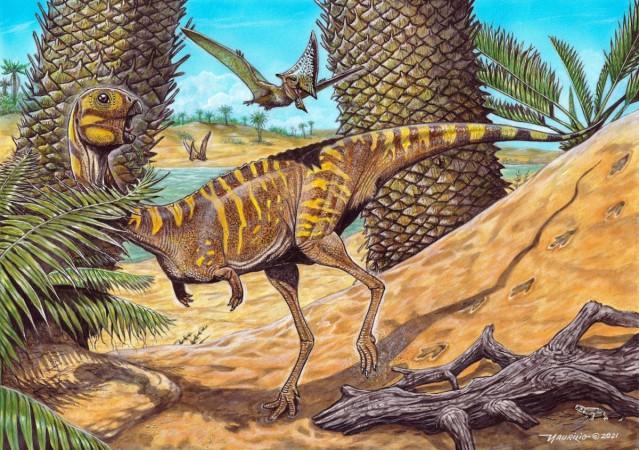The mention of a dinosaur often brings to mind images of a T-rex's large fangs or a Velociraptor's razor-like gnashers. To imagine these fascinating creatures without teeth is almost impossible. Proving that there is more to be learnt about these ancient reptiles, scientists have reported the discovery of a toothless dinosaur in Brazil.
In a new study, a team of Brazilian paleontologists has described a species of edentulous (toothless) dinosaur that was unearthed in southern Brazil. Christened Berthasaura leopoldinae, the animal lived around 80 to 70 million years ago during the Cretaceous period. This is the first cataloged species to not possess teeth during its youth. The findings were published in the journal Nature.
"We never imagined finding a theropod without teeth in Brazil. This demonstrates in a very categorical way: invest in science in the country so that we can make discoveries like this. We can make even more discoveries in that archaeological site, which has great potential," said Dr. Alexander Kellner, corresponding author of the study, in a statement.
In the 'Cemetery of Pterosaurs'

Dinosaurs unburied in Brazil fall largely within two groups: sauropods and theropods. Berthasaura is a theropod. Theropods belong to a large clade of dinosaurs known as Theropoda—a lineage of which well-known carnivores such as Spinosaurus aegyptiacus, Tyrannosaurus rex, and Velociraptor mongoliensis are members. These animals were characterized by their three-toed limbs and hollow bones.
Describing the unearthed skeletal sections—which were in well-preserved condition—of Berthasaura, Dr. Kellner stated, "We have remains of the skull and jaw, spine, pectoral and pelvic girdle and fore and hind limbs, which makes Bertha one of the most complete dinos ever found in the Brazilian Cretaceous period."

Berthasaura's reliquiae were found at the Cemitério dos Pterossauros (meaning 'Cemetery of Pterosaurs') in the municipality of Cruzeiro do Oeste in the state of Paraná, between 2011 and 2014. The region is rich in fossils and several species of pterosaurs and other reptiles have been discovered there. Geovane Alves de Souza, lead author of the study, averred that despite large portions of Berthasaura's body being available, categorizing the specimen was not an easy task.
This complication arose as the fossils of dinosaurs from the same family—noasaurids—are very rare and highly fragmented. In fact, Berthasaur's skull is one of the most complete specimens of theropods in the world. Remains of Elaphrosaurus bambergi, Limusaurus inextricabilis, and Masiakasaurus knopfler are the only other reasonably well-preserved remains of noasaurids that have been found so far.
A Toothless Dinosaur

The most striking feature of the new species was that it was edentulous. While theropods with such characteristics have been found in the past, it was only in specimens who had been in their adulthood. According to researchers, Berthasaura was a young specimen; around 1 m in length, 80 cm in height, and weighed between 8 to 10 kg. This made the finding remarkable.
However, the authors wanted to verify the absence of teeth in the specimen and ascertain whether it was indeed a condition in the animal (rather than being the outcome of poor preservation). So the remains were subjected to extensive image analyses.

Through computerized microtomography, the team was able to confirm the lack of cavities containing teeth in the upper (maxilla) and lower jaws (mandible). Additionally, the images also revealed marks and furrows. This indicates the presence of a horny beak, much like what modern birds possess.
"This aspect of the tooth evokes the questioning of the animal's type of diet. This is not to say that, as it has no teeth, it cannot eat meat, as many birds, such as the falcon and the vulture, do. Most likely, it was an omnivorous animal, since the environment was inhospitable and he needed to take advantage of what it had available," explained de Souza.








